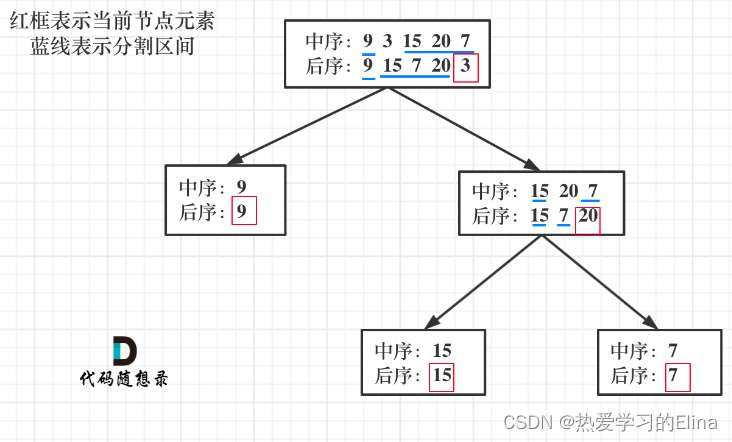代码随想录算法训练营Day18|513.找树左下角的值、112. 路径总和、106.从中序与后序遍历序列构造二叉树
发布时间:2024年01月14日
一、513.找树左下角的值
题目描述: 给定一个二叉树,在树的最后一行找到最左边的值。
1.递归法
- 确定递归函数的参数和返回值
参数必须有要遍历的树的根节点,还有就是一个int型的变量用来记录最长深度。 这里就不需要返回值了,所以递归函数的返回类型为void。- 确定终止条件
当遇到叶子节点的时候,就需要统计一下最大的深度了,所以需要遇到叶子节点来更新最大深度。- 确定单层递归的逻辑
在找最大深度的时候,递归的过程中依然要使用回溯
class Solution {
private int Deep = -1;
private int value = 0;
public int findBottomLeftValue(TreeNode root) {
value = root.val;
findLeftValue(root,0);
return value;
}
private void findLeftValue (TreeNode root,int deep) {
if (root == null) return;
if (root.left == null && root.right == null) {
if (deep > Deep) {
value = root.val;
Deep = deep;
}
}
if (root.left != null) findLeftValue(root.left,deep + 1);
if (root.right != null) findLeftValue(root.right,deep + 1);
}
}
二、112. 路径总和
题目描述: 给定一个二叉树和一个目标和,判断该树中是否存在根节点到叶子节点的路径,这条路径上所有节点值相加等于目标和。
说明: 叶子节点是指没有子节点的节点。
1.递归法
- 确定递归函数的参数和返回类型
参数:需要二叉树的根节点,还需要一个计数器,这个计数器用来计算二叉树的一条边之和是否正好是目标和,计数器为int型。- 确定终止条件
不要去累加然后判断是否等于目标和,那么代码比较麻烦,可以用递减,让计数器count初始为目标和,然后每次减去遍历路径节点上的数值。
如果最后count == 0,同时到了叶子节点的话,说明找到了目标和。
如果遍历到了叶子节点,count不为0,就是没找到。- 确定单层递归的逻辑
因为终止条件是判断叶子节点,所以递归的过程中就不要让空节点进入递归了。
递归函数是有返回值的,如果递归函数返回true,说明找到了合适的路径,应该立刻返回。
class solution {
public boolean haspathsum(treenode root, int targetsum) {
if (root == null) {
return false;
}
targetsum -= root.val;
// 叶子结点
if (root.left == null && root.right == null) {
return targetsum == 0;
}
if (root.left != null) {
boolean left = haspathsum(root.left, targetsum);
if (left) {// 已经找到
return true;
}
}
if (root.right != null) {
boolean right = haspathsum(root.right, targetsum);
if (right) {// 已经找到
return true;
}
}
return false;
}
}
三、106.从中序与后序遍历序列构造二叉树
题目描述: 根据一棵树的中序遍历与后序遍历构造二叉树。
注意: 你可以假设树中没有重复的元素。
1.递归法
- 如果数组大小为零的话,说明是空节点了。
- 如果不为空,那么取后序数组最后一个元素作为节点元素。
- 找到后序数组最后一个元素在中序数组的位置,作为切割点。
- 割中序数组,切成中序左数组和中序右数组 (顺序别搞反了,一定是先切中序数组)。
- 切割后序数组,切成后序左数组和后序右数组。
- 递归处理左区间和右区间。

class Solution {
Map<Integer, Integer> map; // 方便根据数值查找位置
public TreeNode buildTree(int[] inorder, int[] postorder) {
map = new HashMap<>();
for (int i = 0; i < inorder.length; i++) { // 用map保存中序序列的数值对应位置
map.put(inorder[i], i);
}
return findNode(inorder, 0, inorder.length, postorder,0, postorder.length); // 前闭后开
}
public TreeNode findNode(int[] inorder, int inBegin, int inEnd, int[] postorder, int postBegin, int postEnd) {
// 参数里的范围都是前闭后开
if (inBegin >= inEnd || postBegin >= postEnd) { // 不满足左闭右开,说明没有元素,返回空树
return null;
}
int rootIndex = map.get(postorder[postEnd - 1]); // 找到后序遍历的最后一个元素在中序遍历中的位置
TreeNode root = new TreeNode(inorder[rootIndex]); // 构造结点
int lenOfLeft = rootIndex - inBegin; // 保存中序左子树个数,用来确定后序数列的个数
root.left = findNode(inorder, inBegin, rootIndex,
postorder, postBegin, postBegin + lenOfLeft);
root.right = findNode(inorder, rootIndex + 1, inEnd,
postorder, postBegin + lenOfLeft, postEnd - 1);
return root;
}
}
文章来源:https://blog.csdn.net/qq_41929830/article/details/135580329
本文来自互联网用户投稿,该文观点仅代表作者本人,不代表本站立场。本站仅提供信息存储空间服务,不拥有所有权,不承担相关法律责任。 如若内容造成侵权/违法违规/事实不符,请联系我的编程经验分享网邮箱:chenni525@qq.com进行投诉反馈,一经查实,立即删除!
本文来自互联网用户投稿,该文观点仅代表作者本人,不代表本站立场。本站仅提供信息存储空间服务,不拥有所有权,不承担相关法律责任。 如若内容造成侵权/违法违规/事实不符,请联系我的编程经验分享网邮箱:chenni525@qq.com进行投诉反馈,一经查实,立即删除!
最新文章
- Python教程
- 深入理解 MySQL 中的 HAVING 关键字和聚合函数
- Qt之QChar编码(1)
- MyBatis入门基础篇
- 用Python脚本实现FFmpeg批量转换
- css左右布局 右侧的父级是flex:1 子集的文本设置width: 100% 超出用... 会撑爆父
- 【Python 零基础入门】 函数
- 【智慧校园】基于国标GB28181协议EasyCVR视频技术的高校宿舍智能监管方案
- Cmake
- 优雅的避免代码嵌套 (表驱动 | 状态模式 | lambda | 编程 | 断言和前置判断 | 设计模式)
- 幻读是什么,用什么隔离级别可以防止幻读?
- 【MySQL实践】一个隐蔽的问题导致 Field ‘xxx‘ doesn‘t have a default value
- 猜凶手/杨辉三角/变种水仙花数
- java常见面试题:请解释一下Java中的常用ORM框架,如Hibernate、MyBatis等。
- 多级缓存架构(三)OpenResty Lua缓存